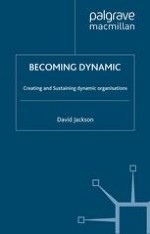2000 | OriginalPaper | Chapter
Bounded vs Dynamic Change
Author : David Jackson
Published in: Becoming Dynamic
Publisher: Palgrave Macmillan UK
Included in: Professional Book Archive
Activate our intelligent search to find suitable subject content or patents.
Select sections of text to find matching patents with Artificial Intelligence. powered by
Select sections of text to find additional relevant content using AI-assisted search. powered by
In organisations there are two distinct but closely interrelated cycles of change. Every organisation needs to continually examine its products and processes and find better ways of doing those activities that are necessary. New systems have to be introduced, new products brought to market and improvements to the way the organisation does business implemented. This type of change, I will call it bounded change, is bounded, with a clear end goal; the process delivers a change. The change may vary in scale or scope: a small team working on improving one of their processes, the introduction of a new organisation wide accounting system, or the delivery of a company-wide branding are all examples of bounded change. By bounded I do not mean that the change is necessarily easy to effect. Few changes are. I use the phrase because change of this nature involves bounded problems and end-points. There is a known goal to aim for, even if that goal is developed as part of the process of change.
